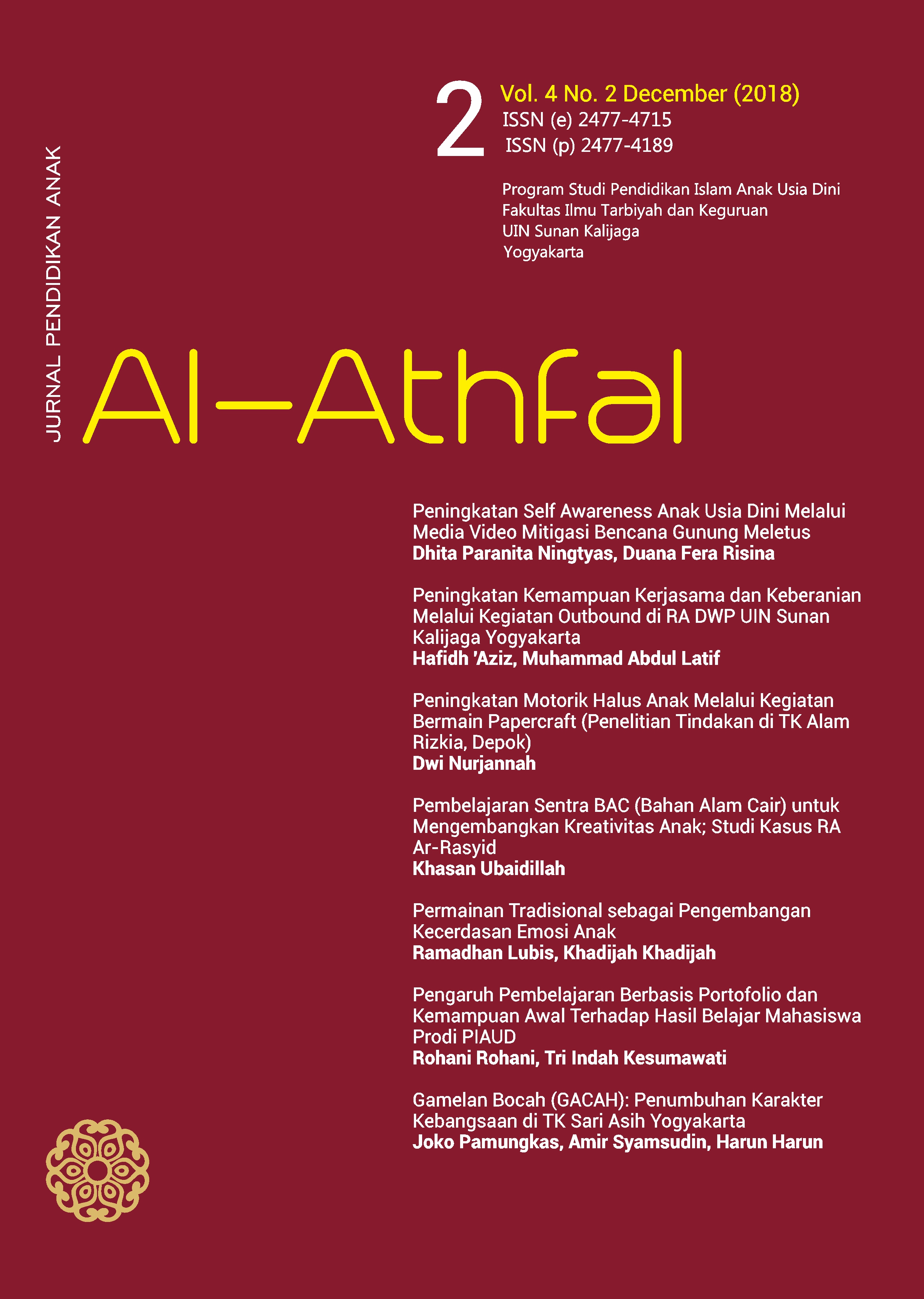368
Views
485
Downloads
 Open Access
Open Access
Gamelan Bocah (GACAH): Penumbuhan Karakter Kebangsaan di TK Sari Asih Yogyakarta
Main Article Content
Abstract
This study aims to describe the children gamelan media in fostering national character values such as tolerance, responsibility, independence, adaptation, courtesy and discipline, and finalize the achievements of gross motoric development, fine motor skills, cognitive, and the early childhood art. This research method uses quasi-experiment. The variables consisted of playing children gamelan, children development, and national character values. The subjects were 16 students aged 4-6 years of Sari Asih Kindergarten, Catur Tunggal, Depok, Sleman, Yogyakarta. This research starts from learning using children gamelan media and observing children national character behavior as well as the achievements of the children development. Data collection techniques use observation sheets for national character behavior and unstructured interview guidelines. The data analysis technique uses descriptive-qualitative. The results showed that playing children gamelan can accelerate the stimulation of the values of tolerant, responsible, and children independent characters, and can finalize the achievement of gross and cognitive motor development.
Keywords:
Downloads
Article Details
How to Cite
Copyright
Authors who publish with this journal agree to the following terms:
- Authors retain copyright and grant the journal the right of first publication with the work simultaneously licensed under a Creative Commons Attribution License that allows others to share the work with an acknowledgment of the work's authorship and initial publication in this journal.
- Authors can enter into separate, additional contractual arrangements for the non-exclusive distribution of the journal's published version of the work (e.g., post it to an institutional repository or publish it in a book), with an acknowledgment of its initial publication in this journal.
- Authors are permitted and encouraged to post their work online (e.g., in institutional repositories or on their website) before and during the submission process. It can lead to productive exchanges and earlier and greater citation of published work.
References
Fauzi, A., Harisyah, A., Rudy, & Samsu, Alam, Panggabean, R. (2009). Pola-pola Konflik Keagamaan di Indonesia (1990-2008). Jakarta.
Hakim, B. A., & Pusat Litbang Kehidupan Beragama (Indonesia). (2010). Pandangan Masyarakat Terhadap Tindak Kekerasan Atas Nama Agama : Studi Hubungan Antara Pemahaman Keagamaan dengan Tindak Kekerasan Atas Nama Agama. Kementerian Agama RI, Badan Litbang dan Diklat, Puslitbang Kehidupan Keagamaan.
Lay, C. (2009). Kekerasan Atas Nama Agama: Perspektif Politik. Jurnal Ilmu Sosial Dan Ilmu Politik, 13(1), 1–19. https://doi.org/10.22146/JSP.10964
Meinarno, E. A., & Mashoedi, S. F. (2016). Pembuktian Kekuatan Hubungan Antara Nilai-Nilai Pancasila dengan Kewarganegaraan. Jurnal Ilmiah Pendidikan Pancasila Dan Kewarganegaraan, 1(1), 12–22. https://doi.org/10.17977/JIPPK.V1I1.5932
Permendikbud Nomor 146 Tahun 2014 Kurikulum 2013 PAUD. (n.d.).
Prapsiwi, D. (2013). Pengelolaan Pembelajaran Anak Usia Dini (Studi Situs di TK Negeri Pembina Boyolali).
Sagala, S. (2005). Konsep dan Makna Pembelajaran. Bandung: Alfabeta.
Sujiono, Y. N. (2013). Konsep Dasar Pendidikan Anak Usia Dini. Jakarta: PT. Indeks. https://doi.org/2013
UU No 20 2003 Sistem Pendidikan Nasional. (n.d.).




